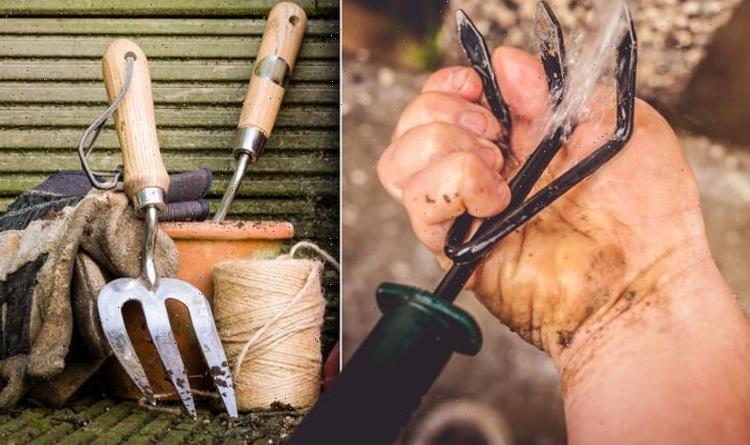Gardening hacks: Expert reveals how you can use vinegar
When you subscribe we will use the information you provide to send you these newsletters. Sometimes they’ll include recommendations for other related newsletters or services we offer. Our Privacy Notice explains more about how we use your data, and your rights. You can unsubscribe at any time.
Garden tools are widely used as part of the gardening routine, including spades, hoes, forks, secateurs, knives, and even pruning saws. But over time your tools may become gunky from sap, as well as dirty from remnants of soil. Cleaning your tools is simple, and it won’t take you a long time, either.
Gardeners tend to use their tools for cultivating and cutting plants in their garden.
But they can also be used to get rid of any unwanted weeds, or for deadheading flowers.
Cleaning your tools is imperative, because they’re more efficient and effective when they’re clean and sparkly.
Continually using dirty tools also increases the chances of spreading disease around your plants.
How to clean garden tools
The method you’ll want to follow entirely depends on which type of tool you’re cleaning.
They’re generally broken up into cutting tools and cultivation tools.
Cutting tools are generally smaller, including secateurs, loppers, knives, and pruning saws.
Cultivation tools are larger – with a few exceptions – including spades, forks and trowels.
DON’T MISS
Monty Don issues warning over gardening tool [QUOTES]
Lidl’s sell-out fire pit is back this weekend for just £25 [LATEST]
Lidl launches bargain cordless hedge trimmer today – and it’s just £25 [NEWS]
Cutting tools tend to get grimy and dirty after pruning individual plants.
They can also become sticky from sap, which affects performance over time.
The first thing you should do is to wipe away any dried sap with a scourer or wire wool.
If you’re struggling, a touch of WD-40 should help to loosen the sap.
Wipe away the excess WD-40 with a clean cloth, leaving the metal nice and clear.
Drop a touch of oil into the central pivot point, and then open and close the tool a number of times to work it in.
The Royal Horticultural Society (RHS) said: “Store in a clean dry place.
“Wear gloves when using oil products to prevent skin irritation or splinters from wire wool.”
Elsewhere, if you’re looking to clean cultivation tools, you’ll need a stiff scrubbing brush to get rid of any excess soil from the blades and shaft.
If you’re using water to hose down your tools, making sure to dry the wooden handles to stop it swelling.
“Traditionally after cleaning, tools were oiled with a thin protective film of general-purpose oil, to help prevent rusting,” said the RHS.
“Many modern tools are made from stainless steel, which is less likely to rust. However, this does depend on the quality of the metal. Occasional oiling may be required.”
Source: Read Full Article


